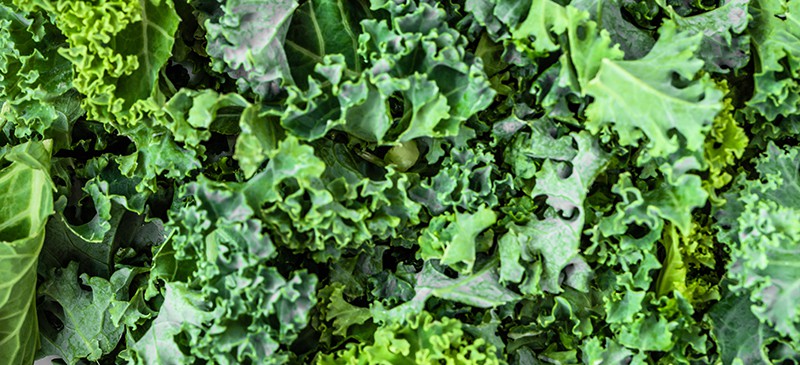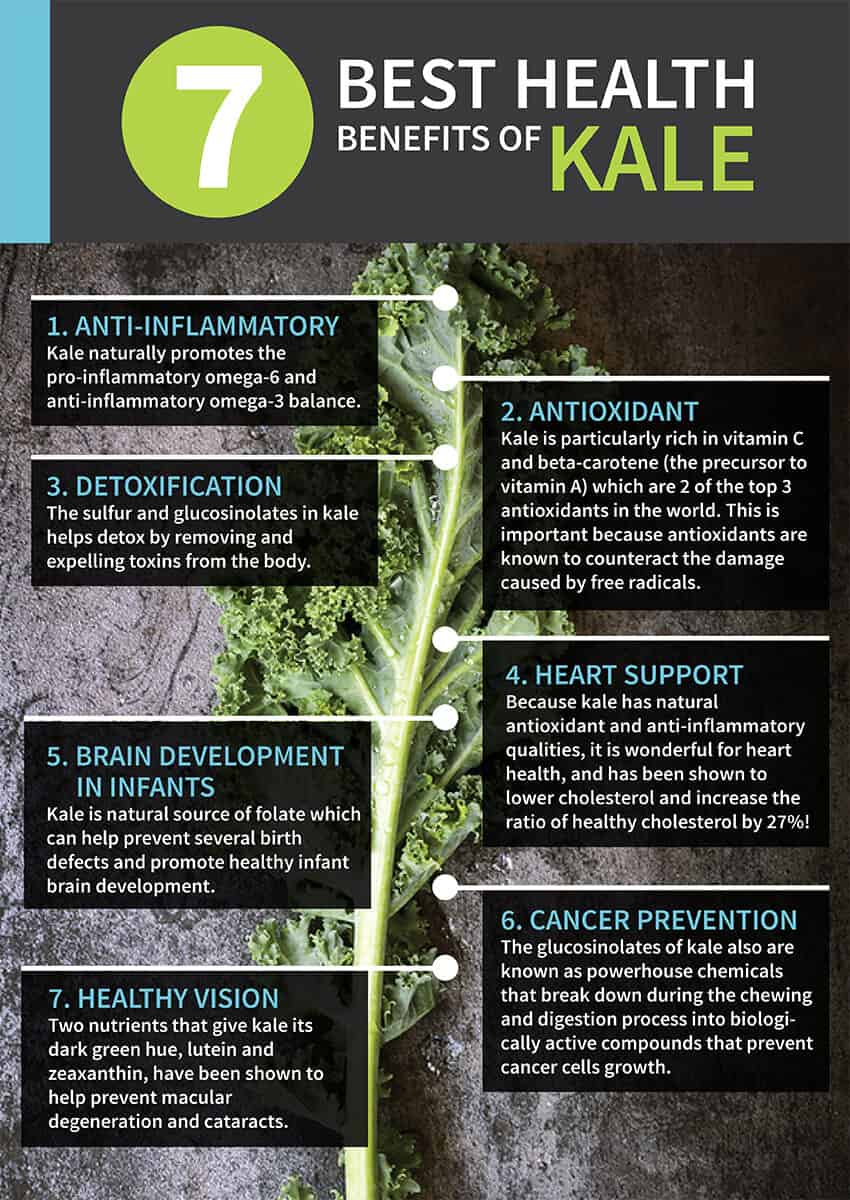
Kale Health Benefits
Everyone seems to be talking about green smoothies, superfood shakes, and vegetable juices nowadays, and for a good reason.
All around the world, people are learning that including more healthy greens in your diet can help curb cravings, boost immunity, and support overall health.
Kale is one of the most common veggies found in these superfood concoctions.
Not only does the cooked kale nutrition profile boast a wide array of essential vitamins, minerals, and antioxidants, but this superstar ingredient is featured in nearly every eating pattern, from the Mediterranean diet to Paleo to the ketogenic diet and more.
Rich in vitamins K, A, and C, along with other vital nutrients, there is a multitude of kale benefits for skin, heart health, inflammation, and more.
Please keep reading to learn more about this potent leafy green and some simple ways to add it to your diet.
What Is Kale?
A member of the illustrious group of cancer-fighting cruciferous vegetables, kale is quickly becoming one of the most popular health foods today.
However, the health benefits of kale can be traced back to ancient Rome, and history tells us that it was one of the most popular green leafy vegetables of the Middle Ages.
Kale comes from the Acephala group of the Brassica oleracea (oleracea var) species, which also includes collard greens.
There are two main varieties: one that has green leaves and one that has purple.
Interestingly, the central leaves do not form a head, which is one reason why it is considered to be more closely related to wild cabbage than most domesticated forms of vegetables.
As part of the Brassica oleracea (oleracea var) vegetable species, it is in good company and shares many of the same characteristics as its cousins.
Kale is closely related to vegetables like arugula, bok choy, broccoli, Brussels sprouts, cabbage, cauliflower, and more.
Types of Kale
There are several different types of kale, each of which differs based on its unique appearance, color, and taste. Some of the most common types include:
- Curly kale
- Lacinato kale (Dinosaur kale)
- Red Russian kale
- Redbor kale
- Walking stick kale
- Premier kale
- Siberian kale

Nutrition Facts
Kale is an excellent source of many essential nutrients, including fiber, vitamin K, vitamin A, and vitamin C.
One cup of raw kale contains the following nutrients:
- 33.5 calories
- 6.7 grams carbohydrates
- 2.2 grams of protein
- 0.5-grams fat
- 1.3 grams of dietary fiber
- 547 micrograms vitamin K (684 percent DV)
- 10,302 IU vitamin A (206 percent DV)
- 80.4 milligrams vitamin C (134 percent DV)
- 0.5-milligram manganese (26 percent DV)
- 0.2-milligram copper (10 percent DV)
- 0.2-milligram vitamin B6 (9 percent DV)
- 90.5 milligrams calcium (9 percent DV)
- 299 milligrams potassium (9 percent DV)
- 1.1 milligrams iron (6 percent DV)
- 22.8 milligrams magnesium (6 percent DV)
- 0.1-milligram thiamine (5 percent DV)
- 0.1-milligram riboflavin (5 percent DV)
- 19.4 micrograms folate (5 percent DV)
- 37.5 milligrams phosphorus (4 percent DV)
In addition to the nutrients above, each serving also contains a small amount of niacin, zinc, pantothenic acid, and selenium.
Kale Health Benefits
Besides being highly nutritious, kale has also been associated with several health benefits. Here are a few of the top reasons to consider adding this leafy green to your next shopping list.
1. Fights Inflammation
Arguably the most beneficial property of eating kale is its ability to relieve inflammation, thanks to its content of antioxidants.
Antioxidants are essential compounds that can help fight free radical damage, reduce oxidative stress and, most notably, decrease inflammation.
What’s more, each serving also provides the right amount of plant-based omega-3 fatty acids in the form of alpha-linolenic acid (ALA). Omega-3 fatty acids are involved in several aspects of health and are especially crucial for the regulation of inflammatory processes in the body.
2. Rich in Antioxidants
Going hand-in-hand with its anti-inflammatory potency, kale is one of the top antioxidant foods. It’s incredibly rich in vitamin C and beta-carotene, which is the precursor to vitamin A.
Not only can antioxidants help protect against cell damage caused by free radicals, but they also play a central role in health and disease.
Research shows that antioxidants could be especially beneficial against chronic conditions such as heart disease, cancer, and diabetes.
3. Aids in Detoxification
One of the top health benefits of this cruciferous vegetable is its ability to detoxify the body naturally. It not only helps remove toxins but also helps eliminate them.
This is due to the presence of isothiocyanates (ITCs), which are a compound found in kale that has been shown to help detox your body at the cellular level.
These ITCs are a powerful “one-two punch” against toxins and free radicals.
They also help stimulate the production of phase II enzymes, which are responsible for detoxifying the body by promoting the excretion of harmful substances.

4. Supports Heart Health
The powerful antioxidant and anti-inflammatory properties of kale make it a perfect food for promoting heart health.
It also contains many micronutrients that are crucial to heart health, including vitamin K, potassium, and omega-3 fatty acids.
Several studies have confirmed the heart-boosting benefits of kale. One study out of Seoul even found that drinking 5 ounces of kale juice daily for 12 weeks increased levels of HDL (good) cholesterol by 27 percent and reduced levels of LDL (bad) cholesterol by 10 percent.
Other studies have found that it could also decrease blood pressure and stabilize blood sugar levels, both of which are major risk factors for heart disease.
5. Promotes Healthy Development
Another one of the critical benefits of kale is its ability to promote healthy fetal development.
This is because it is a valuable source of folate, which is essential for preventing congenital disabilities and promoting healthy neural tube formation.
Getting enough folate in your diet may also reduce the risk of other pregnancy complications, including anemia and preterm birth.
Kale is also high in vitamin K, calcium, and copper, all of which are necessary for bone health and skeletal formation during pregnancy.
Getting enough of these nutrients is also important during breastfeeding, as studies show that women can lose 3-5 percent of bone mass while breastfeeding due to the baby’s increased need for calcium.
6. Decreases Cancer Cell Growth
Cruciferous vegetables, including kale, have been extensively studied for their ability to inhibit the growth of cancer cells in vitro.
According to the National Cancer Institute, the secret behind the cancer-killing ability of cruciferous veggies is that they’re rich in glucosinolates, which are a large group of sulfur-containing compounds.
These powerhouse chemicals are known to break down in the digestive tract and form biologically active compounds, including indoles, thiocyanates, and isothiocyanates.
Although more research is needed in humans, indoles and isothiocyanates have been shown to protect against cancer of the bladder, breast, colon, liver, lung, and stomach in animal models and in vitro studies.
7. Enhances Eye Health
Another one of the fantastic health benefits of kale is it can improve your eyesight, thanks to the presence of lutein and zeaxanthin, two compounds that give this leafy green its signature hue and have been shown to help prevent macular degeneration and cataracts.
Both lutein and zeaxanthin act as antioxidants in the eye and filter harmful high-energy blue wavelengths of light.
According to the American Optometric Association (AOA), they also protect and maintain healthy cells, which may help prevent retinal damage and preserve vision.
Recipes
Kale is versatile and easy to enjoy in a variety of different recipes. It works exceptionally well paired with fruit and blended into a kale smoothie.
You can also try baking a batch of Kale Chips for a simple snack that’s great if you’re on the go. Here are a few other cooking tips and easy ways to enjoy kale:
- Steam for a few minutes (making sure not to overcook them and denature the proteins) and use in stir-fries or vegetable dishes.
- Shred into thin slices and eat raw in salads or use as a garnish
- Lightly sauté with coconut oil, fresh garlic cloves, and some onions for a simple side dish.
You can also make kale juice, add it to soup or use it to help ramp up the nutritional profile of any meal and enjoy Kale Health Benefits.
Where to Buy
Kale is available at most grocery stores and supermarkets and can be found in the produce aisle, alongside other leafy greens and vegetables.
Keep in mind that kale is one of the heaviest pesticides sprayed crops, so be sure to buy organic whenever possible to minimize your exposure.
Washing produce thoroughly can also help remove any pesticide residue, along with bacteria, dirt, and debris.
To wash kale, remove the stems and submerge in water completely. Then, rinse under running water to remove any remaining residue.
Risks and Side Effects
Despite the impressive kale nutrition facts and potential benefits of this cruciferous veggie, there are a few risks and side effects to consider as well.
Although uncommon, some people may be allergic to cruciferous vegetables, including kale.
If you experience any adverse side effects after eating this leafy green, discontinue consumption immediately and talk to your doctor.
Keep in mind that kale is also very high in vitamin K.
For those on blood thinners, maintaining a steady intake of vitamin K is crucial.
While greens like kale vs. spinach can still be enjoyed in moderation, it’s best to talk to your doctor before making any drastic changes to your diet.
Final Thoughts on Kale Health Benefits
- Kale is a cruciferous vegetable that is closely related to other veggies, including broccoli, Brussels sprouts, cabbage, and bok choy.
- What is kale good for? In addition to providing plenty of fiber, vitamin K, vitamin A, and antioxidants, potential kale benefits include decreased inflammation, enhanced detoxification, improved heart health, reduced cancer cell growth, healthy fetal development, and improved vision.
- There are several options for how to eat kale, and plenty of delicious kale recipes to choose from. This exquisite leafy green works exceptionally well in smoothies, shakes, salads, and side dishes and can be consumed raw or cooked.
- Be sure to select organic varieties whenever possible and wash produce thoroughly to reduce exposure to pesticides.
- Additionally, talk to your doctor if you experience any food allergy symptoms or are taking blood thinners such as Warfarin.







